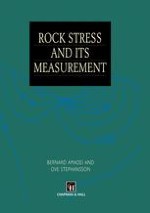1997 | OriginalPaper | Buchkapitel
Using Stresses in Rock Engineering, Geology and Geophysics
verfasst von : Bernard Amadei, Ove Stephansson
Erschienen in: Rock Stress and Its Measurement
Verlag: Springer Netherlands
Enthalten in: Professional Book Archive
Aktivieren Sie unsere intelligente Suche, um passende Fachinhalte oder Patente zu finden.
Wählen Sie Textabschnitte aus um mit Künstlicher Intelligenz passenden Patente zu finden. powered by
Markieren Sie Textabschnitte, um KI-gestützt weitere passende Inhalte zu finden. powered by
Rock masses are initially stressed in their natural state. Whether one is interested in natural geological structures (folds, faults, intrusions, etc.) or artificial structures (tunnels, caverns, mines, surface excavations, etc.), a knowledge of the in situ or virgin stress field (along with other rock mass properties) is needed when predicting the response of rock masses to the disturbance associated with those structures. The response can take multiple forms such as deformations of the walls of a surface or underground excavation, stresses and breakouts in the walls of a shaft or borehole, creep of a salt pillar, initiation of a microearthquake, shearing of a fault or glacial rebound of a glaciated terrain. Today, there exist a variety of analytical solutions to many of the geological, geophysical and geoengineering problems. Computer-based numerical methods for stress, strain and strength analysis are also available to handle problems with more complex geometries and/or constitutive behavior. Many of the analytical methods and numerical codes use stress (or traction) as a possible boundary condition. Hence, a proper determination, or at least a good estimation, of the state of stress in situ is needed in order to reach reliable solutions to the problem of interest.
